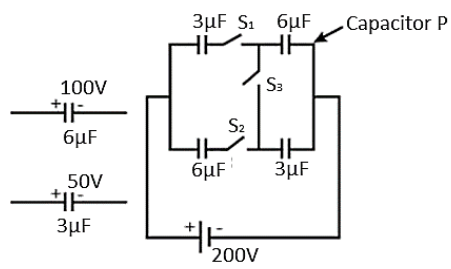
A capacitor circuit consists of two $6\mu F$ and $3\mu F$ capacitors is initially charged to 100V and 50V respectively now connected to a source of EMF 200 volt through the switches $S_1,S_2$ and $S_3$ as shown in the figure below. Charge on capacitor P, in steady state, when $S_1$ is closed.


Answer
586.8k+ views
Hint: We first need to know how the circuit looks when the switch $S_1$ is closed. Then we’ll find out the equivalent capacitance of the circuit using the formula $\dfrac{1}{C}=\dfrac{1}{C_1}+\dfrac{1}{C_2}$, where charge can be found using the formula, $q=CV$. Therefore, the final result can be easily found out.
Formula used:
$\dfrac{1}{C}=\dfrac{1}{C_1}+\dfrac{1}{C_2}$
Complete step-by-step solution:
It is said that the capacitors are initially charged.
Let $C_1=3\mu F$ and $C_2=6\mu F$.
It is given in the question that the initial voltage across the first capacitor is $C_1$ is 50V. And the initial voltage across the second capacitor $C_2$ is 100V.
So, the charge of first capacitor $C_1$ is,
${{q}_{1}}={{C}_{1}}.{{V}_{1}}=3\mu \times 50=150\mu $ Coulomb
Similarly, the charge across the second capacitor is given by,
${{q}_{2}}={{C}_{2}}.{{V}_{2}}=6\mu \times 100=600\mu $ Coulomb
But when the circuit is connected to the 200 volt source, the charges are redistributed in a new way.
In order to find this new charge, we need to find the equivalent capacitance of the circuit. Imagine only $S_1$ is closed and all the other keys are opened. So, the two capacitors are in series connections. Equivalent capacitance is given by,
$\dfrac{1}{C}=\dfrac{1}{C_1}+\dfrac{1}{C_2}$
After putting the values in the formula, we obtain,
$\begin{align}
& \dfrac{1}{C}=\dfrac{1}{3\mu }+\dfrac{1}{6\mu } \\
& \Rightarrow \dfrac{1}{C}=\dfrac{2+1}{6\mu } \\
& \Rightarrow \dfrac{1}{C}=\dfrac{3}{6\mu } \\
\end{align}$
$\therefore C=2\mu F$
The voltage across this new equivalent capacitor is 200V. Now the charge along the equivalent capacitor is given by,
\[q=CV=2\mu \times 200=400\mu \] Coulomb
In series connection of capacitors, all the capacitors possess the same amount of charge. So, the charge across the capacitor P is \[400\mu \] or 0.004 Coulomb.
Additional information:
When two or more capacitors are connected in parallel connection, their equivalent capacitance is given by the sum of the individual capacitances, i.e., $C={{C}_{1}}+{{C}_{2}}+...$.
Note: Don’t get bothered about the initial charges of the capacitors. Since it is mentioned in the question that we have to find the charge on “steady state”, we only need to consider the final conditions of the circuit. In case of parallel connection, the charge on each individual capacitor is not the same.
The problem occurs when the circuit is considered as having parallel capacitor connections rather than series capacitor connections, the answer will not be the same.
Formula used:
$\dfrac{1}{C}=\dfrac{1}{C_1}+\dfrac{1}{C_2}$
Complete step-by-step solution:
It is said that the capacitors are initially charged.
Let $C_1=3\mu F$ and $C_2=6\mu F$.
It is given in the question that the initial voltage across the first capacitor is $C_1$ is 50V. And the initial voltage across the second capacitor $C_2$ is 100V.
So, the charge of first capacitor $C_1$ is,
${{q}_{1}}={{C}_{1}}.{{V}_{1}}=3\mu \times 50=150\mu $ Coulomb
Similarly, the charge across the second capacitor is given by,
${{q}_{2}}={{C}_{2}}.{{V}_{2}}=6\mu \times 100=600\mu $ Coulomb
But when the circuit is connected to the 200 volt source, the charges are redistributed in a new way.
In order to find this new charge, we need to find the equivalent capacitance of the circuit. Imagine only $S_1$ is closed and all the other keys are opened. So, the two capacitors are in series connections. Equivalent capacitance is given by,
$\dfrac{1}{C}=\dfrac{1}{C_1}+\dfrac{1}{C_2}$
After putting the values in the formula, we obtain,
$\begin{align}
& \dfrac{1}{C}=\dfrac{1}{3\mu }+\dfrac{1}{6\mu } \\
& \Rightarrow \dfrac{1}{C}=\dfrac{2+1}{6\mu } \\
& \Rightarrow \dfrac{1}{C}=\dfrac{3}{6\mu } \\
\end{align}$
$\therefore C=2\mu F$
The voltage across this new equivalent capacitor is 200V. Now the charge along the equivalent capacitor is given by,
\[q=CV=2\mu \times 200=400\mu \] Coulomb
In series connection of capacitors, all the capacitors possess the same amount of charge. So, the charge across the capacitor P is \[400\mu \] or 0.004 Coulomb.
Additional information:
When two or more capacitors are connected in parallel connection, their equivalent capacitance is given by the sum of the individual capacitances, i.e., $C={{C}_{1}}+{{C}_{2}}+...$.
Note: Don’t get bothered about the initial charges of the capacitors. Since it is mentioned in the question that we have to find the charge on “steady state”, we only need to consider the final conditions of the circuit. In case of parallel connection, the charge on each individual capacitor is not the same.
The problem occurs when the circuit is considered as having parallel capacitor connections rather than series capacitor connections, the answer will not be the same.
Recently Updated Pages
Master Class 12 English: Engaging Questions & Answers for Success

Master Class 12 Business Studies: Engaging Questions & Answers for Success

Master Class 12 Economics: Engaging Questions & Answers for Success

Master Class 12 Social Science: Engaging Questions & Answers for Success

Master Class 12 Maths: Engaging Questions & Answers for Success

Master Class 12 Chemistry: Engaging Questions & Answers for Success

Trending doubts
Explain sex determination in humans with line diag class 12 biology CBSE

Explain sex determination in humans with the help of class 12 biology CBSE

Differentiate between homogeneous and heterogeneous class 12 chemistry CBSE

Dihybrid cross is made between RRYY yellow round seed class 12 biology CBSE

What is virtual and erect image ?

What is the Full Form of PVC, PET, HDPE, LDPE, PP and PS ?




